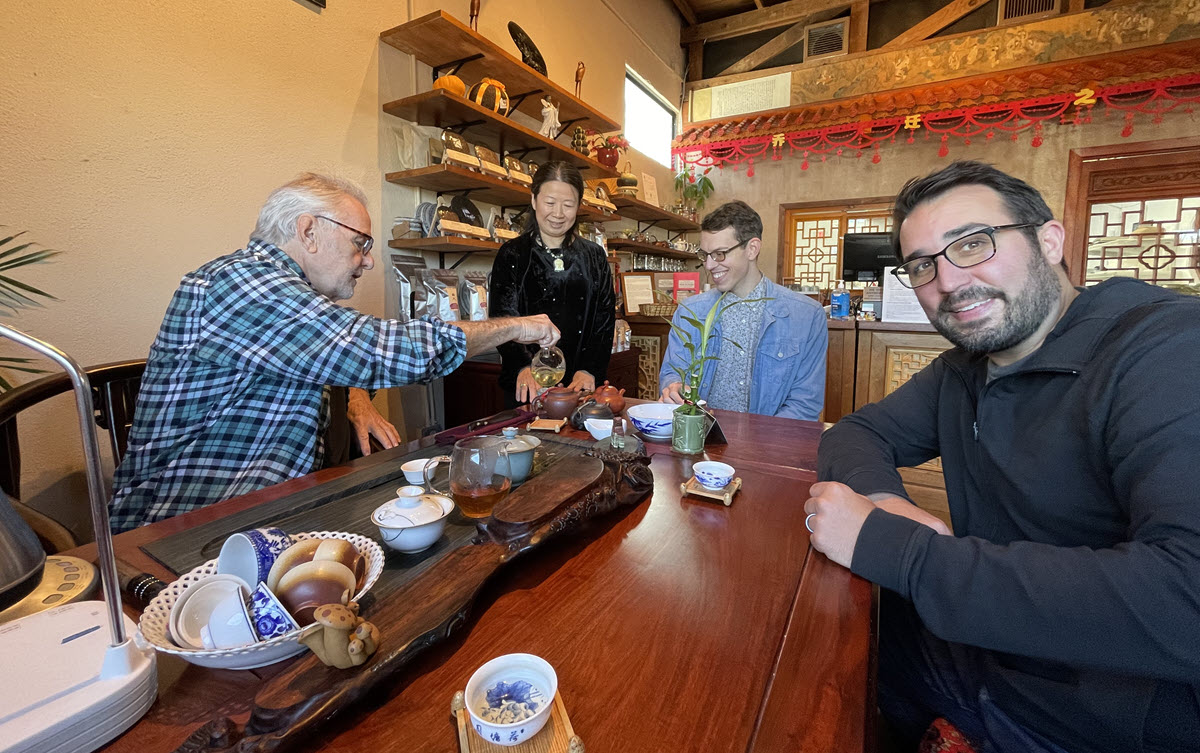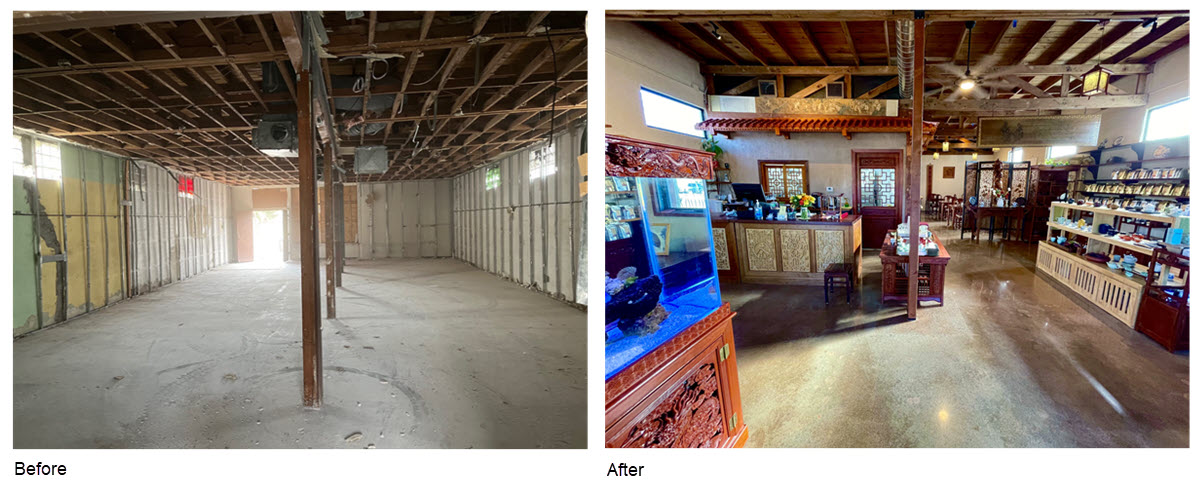
By Austin Hodge
On the twentieth anniversary of Seven Cups Fine Tea, we opened the doors of our new teahouse. It was a project that had taken a decade to complete. It would not have happened without the help of friends, both here and in China.
As we closed our old tea house, I interviewed many customers about their experiences. The word I heard the most often was “intimacy.” What creates an intimate experience in an open room with occupied tables and chairs? Intimacy requires letting down the defenses you need to function in the world. Being in a “safe place” is not enough, so what then?
We were in our old location for 18 years, so there were a lot of sad feelings when it came time to leave, both for ourselves and our customers. We were acutely aware of the risks of moving to a new space and had set the bar high for the new tea house.
The central question was not only if we could recreate the experience but if we could make it even more prosperous.
The goal for our space was rooted in the classical image of a community tea house. Stepping into the teahouse should feel like stepping out of the daily world into a place of beauty — of carved wood, paintings, sculpture, calligraphy, and delicate porcelain. It would be lit with silk and stone lamps. Music would be playing at just the right volume, and the tea served must exceed the drinker’s expectations even more than the environment where it is done. There sits the goal.
Teahouse culture varied across China but always brought status to the town and cities with one. It was a symbol of sophistication. As an institution, it gave its patrons a respite from the grinding labor that came with daily life, perhaps a glimpse of the existence of the immortals.
Tea is elemental to the experience. In China, a gift-giving culture, the most coveted gift is the gift of tea. It is a practical present that brings a wish for a long life. The quality of the tea reflects the sincerity of that wish. It is the gift offered to the bride and groom’s parents and the Emperor of China’s gift to his ancestors, given in the Temple of Heaven.

With that spirit in mind, Zhuping Hodge, a Chinese immigrant obsessed with tea culture, started serving tea to Americans at a local farmers’ market in 2003. The typical reaction was surprising. “Is this really tea?” There was always a line at our booth. By spring 2004, our customer base was big enough to open a tea house. So, we rented a shop in a strip mall with suicidal parking in a gentrified old Tucson neighborhood.
We didn’t have much to work with initially, but we had what mattered. We had Chinese teas, many of them rare in America and some that were rare in China. We also had detailed information about those teas, which was only available from each tea maker. Each tea also came with a story grounded in Chinese Tea Culture. We had the belief to treat all our customers with dignity and respect. Our servers were trained in tea service and knew the details and stories that came with the teas. We only had about twenty teas, but they were good.
Our tea was expensive for working-class Tucson, a scorching and dusty town. Smart money didn’t give us a year. Still, we hit a milestone when three Mexican transmission mechanics brought their girlfriends in for tea on Friday afternoon after work. After that, our community gradually found us, sustained us, and grew around our teahouse for over 18 years.
How, then, would we preserve the same experience that our community had come to expect? Our answer was to focus on the details – firstly, the details of the construction of the place itself and then the details of operating it.
Our small staff accumulated 75 years of experience as Seven Cups employees. Andrew McNeil, our general manager, accounts for 15 of those years. Our staff helped design the new building based on that experience.
We sail on the river of authenticity, kept afloat by addressing the details. All the wood in our tea house was handmade and skillfully carved. All the artwork, doors, windows, and shelving are the same. We brought lanterns, calligraphy, paintings, and even our hand-carved saltwater fish tank from China.
The building had not been maintained since the 1980s and needed to be fixed. It smelled of mold. We got three walls, a roof, and a foundation. Nothing was square or plum.
Since then, every inch has been skillfully addressed. As a result, it is safe to say the building is sounder now than when it was first built in 1948. Dan Taylor, an old friend and tea lover, did the work, and we celebrated our grand opening on his birthday.
The east wall now displays a mural of 1000 square feet. It took six coats of paint, three for the base and three for the mural itself, totaling 380 hours of painting needed to finish. The artist, Jodie Lewers, expanded the details to include augmented reality. Tucson is a city of murals, and Jodie has serious street cred.
More than a pretty building is needed to build the experience we want at our teahouse. Subliminal experience counts a lot. The experience results from small details that must be addressed daily, meaning seven days a week, 362 days per year, and these details fill many long lists. Few people consciously notice if everything has been dusted on the 1,000 square feet of shelf space if the tea in the pot was measured correctly, if the feng shui table has fresh offerings, or whether the staff correctly answered a thousand questions asked by the customers, or if the leaves were broken in a panicked package of tea, or if every order is shipped the day it comes in, or if all the bills are paid on time, if newsletters were written, a website maintained, and the inventory correct. It’s a long sentence. The list of details is much longer. People relax when they intuit that all the details are being addressed.
Our tea master, my wife Zhuping, created our teahouse culture. Zhuping is the master of details. She conducts the teahouse as would a renowned symphony conductor. She knows the complex rhythms and the notes of every instrument in tune.
In that mural on the side of the building, titled “Monsoon Dragon,” Zhuping leads us into the tea house in an image entangled with her long black hair, over the Catalina Mountains, through the monsoon clouds that bring life to our lush desert, filling Lu Tong’s seven cups of tea. A Green Dragon flies with the clouds, symbolizing the East, new life, and a fresh beginning.
Seven Cups is 20 years old and just getting started. Our dream is it will outlive us both.

This was a lovely read, thank you! I discovered Seven Cups last year and have been enjoying their tea (bought online) nonstop. I’m very excited see the tea house for the first time later this week when I visit my hometown of Tucson for the first time since Covid.